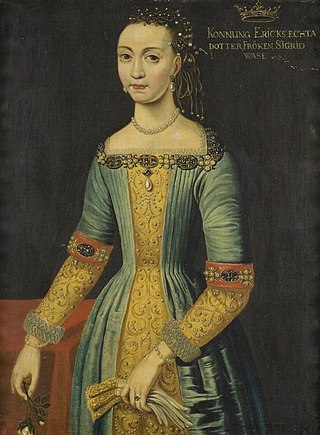Related Research Articles
The British royal family comprises King Charles III and his close relations. Charles is the head of the House of Windsor. There is no strict legal or formal definition of who is or is not a member, although the Royal Household has issued different lists outlining who is a part of the royal family. Members often support the monarch in undertaking public engagements, and pursue charitable work and interests. The royal family are regarded as British and world cultural icons.

Morganatic marriage, sometimes called a left-handed marriage, is a marriage between people of unequal social rank, which in the context of royalty or other inherited title prevents the principal's position or privileges being passed to the spouse, or any children born of the marriage. The concept is most prevalent in German-speaking territories and countries most influenced by the customs of the German-speaking realms.
A queen consort is the wife of a reigning king, and usually shares her spouse's social rank and status. She holds the feminine equivalent of the king's monarchical titles and may be crowned and anointed, but historically she does not formally share the king's political and military powers, unless on occasion acting as regent.
A prince consort is the husband of a monarch who is not a monarch in his own right. In recognition of his status, a prince consort may be given a formal title, such as prince. Most monarchies do not allow the husband of a queen regnant to be titled as a king because it is perceived as a higher title than queen, however, some monarchies use the title of king consort for the role.
The Malay language has a complex system of styles, titles and honorifics which are used extensively in Brunei Darussalam, Malaysia and Singapore.
Consort may refer to:
Royal Highness is a style used to address or refer to some members of royal families, usually princes or princesses. Kings and their female consorts, as well as queens regnant, are usually styled Majesty.

A queen regnant is a female monarch, equivalent in rank and title to a king, who reigns suo jure over a realm known as a "kingdom"; as opposed to a queen consort, who is the wife of a reigning king; or a queen regent, who is the guardian of a child monarch and rules pro tempore in the child's stead, be it de jure in sharing power or de facto in ruling alone. She is sometimes called a woman king. A princess regnant is a female monarch who reigns suo jure over a "principality"; an empress regnant is a female monarch who reigns suo jure over an "empire".
House laws are rules that govern a royal family or dynasty in matters of eligibility for succession to a throne, membership in a dynasty, exercise of a regency, or entitlement to dynastic rank, titles and styles. Prevalent in European monarchies during the nineteenth century, few countries have house laws any longer, so that they are, as a category of law, of more historical than current significance. If applied today, house laws are mostly upheld by members of royal and princely families as a matter of tradition.

The Queen's Service Order, established by royal warrant of Queen Elizabeth II on 13 March 1975, is used to recognise "valuable voluntary service to the community or meritorious and faithful services to the Crown or similar services within the public sector, whether in elected or appointed office". This order was created after a review of New Zealand's honours system in 1974. The Queen's Service Order replaced the Imperial Service Order in New Zealand.
Princess consort is an official title or an informal designation that is normally accorded to the wife of a sovereign prince. The title may be used for the wife of a king if the more usual designation of queen consort is not used.

Princess is a title used by a female member of a monarch's family or by a female ruler. The male equivalent is a prince. Most often, the term has been used for the consort of a prince, or for the daughter of a monarch. A crown princess can be the heir apparent to the throne or the heir apparent's spouse.

The Danish royal family is the dynastic family of the monarch. All members of the Danish royal family except Queen Margrethe II hold the title of Prince/Princess of Denmark Or Count/Countess of Monpezat. Children of the monarch and of the heir apparent are accorded the style of His/Her Royal Highness, while other members of the dynasty are addressed as His/Her Highness. The Queen is styled Her Majesty.
The Spanish royal family, a branch of the House of Bourbon, is headed by King Felipe VI.
A substantive title is a title of nobility or royalty acquired either by individual grant or by inheritance. It is to be distinguished from a title shared among cadets, borne as a courtesy title by a peer's relatives, or acquired through marriage.

Royal tours of Canada by the Canadian royal family have been taking place since 1786—when the future King William IV became the first member of the royal family to visit Canada—and continue into the 21st century, either as an official tour, a working tour, a vacation, or a period of military service by a member of the royal family. In 1939, King George VI became the first reigning monarch to tour the country.

Duchess of Edinburgh is the principal courtesy title held by the wife of the Duke of Edinburgh. There have been five Duchesses of Edinburgh since the title's creation. Following the accession of Charles III in 2022, the 3rd creation of the Dukedom of Edinburgh merged in the Crown. Following his parents’ wishes, on 10 March 2023, Charles III conferred the title Duke of Edinburgh to his youngest brother, Prince Edward, and his wife, Sophie, became the Duchess of Edinburgh.
American royalty may refer to American citizens who are members of royal families, through birth, naturalization or marriage; or American dynastic families that are given the epithet or moniker as American royalty.
References
- ↑ Clarissa Campbell Orr, Queenship in Europe 1660–1815: The Role of the Consort (2004).
- ↑ Association for Gravestone Studies, Markers: The Annual Journal of the Association for Gravestone Studies (2007), Vol. 24, p. 5.
- ↑ "Definition of CONSORT". Merriam-Webster. May 10, 2023. Retrieved May 12, 2023.
- ↑ Wendy Doniger O'Flaherty, Women, Androgynes, and Other Mythical Beasts (1982), p. 78.
- ↑ "The royals dropped 'consort' from Queen Camilla's title. What's the big deal?". NPR. April 5, 2023. Retrieved May 12, 2023.
- ↑ "The Difference Between Queen and Queen Consort". Cosmopolitan. May 5, 2023. Retrieved May 12, 2023.
- ↑ "What is Queen Consort? What will be the role of Camilla?". The Economic Times. 9 September 2022. Retrieved 2022-09-14.
- ↑ Gonzales, Erica (6 May 2023). "Why Prince Philip's Title Wasn't King". Bazaar. Retrieved 12 May 2023.
- ↑ Savin, Jennifer (27 April 2023). "What's the difference between a Queen and a Queen Consort?". Cosmopolitan. Retrieved 12 May 2023.
- ↑ Engber, Daniel (11 February 2005). "What Is a Princess Consort?". Slate. Retrieved 12 May 2023.
- ↑ "Being Whit Fraser: From Reporter to Viceregal Consort". Policy Magazine. September 7, 2022. Retrieved May 12, 2023.
- ↑ Tugwell, James (February 24, 2023). "Youth residential rehabilitation centre opens on the south coast". Bay Post-Moruya Examiner. Retrieved May 12, 2023.
- ↑ "Battle of Britain commemorated – The Valley Profile". The Valley Profile – 100% local community news for the Hauraki Plains, Paeroa and Thames. September 13, 2022. Retrieved May 12, 2023.
- ↑ Lynn Foulston, Hindu Goddesses: Beliefs & Practices (2019), p. 54.